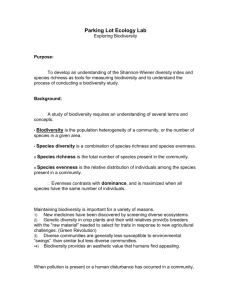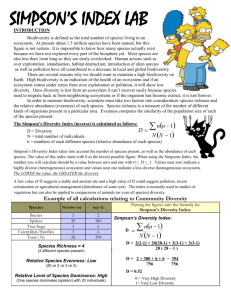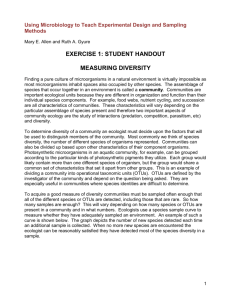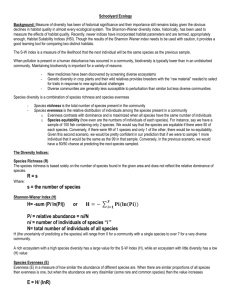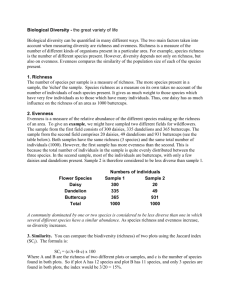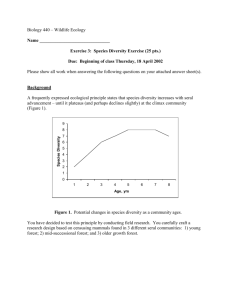Diversity Lab: Shannon-Wiener & Simpson's Index
advertisement
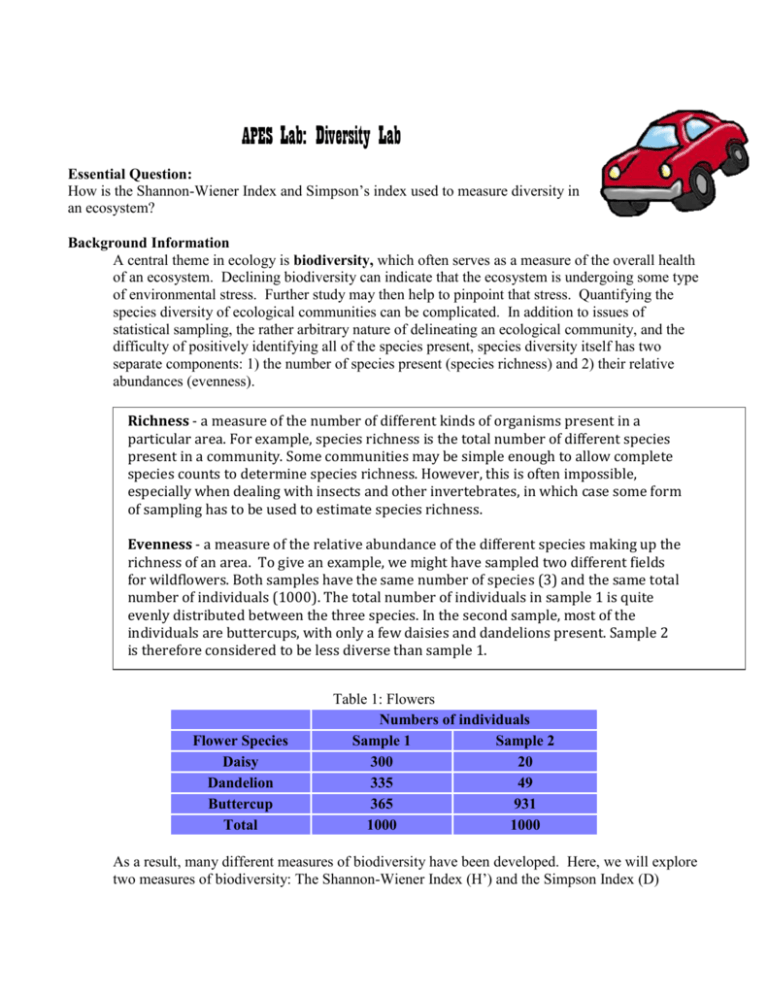
APES Lab: Diversity Lab Essential Question: How is the Shannon-Wiener Index and Simpson’s index used to measure diversity in an ecosystem? Background Information A central theme in ecology is biodiversity, which often serves as a measure of the overall health of an ecosystem. Declining biodiversity can indicate that the ecosystem is undergoing some type of environmental stress. Further study may then help to pinpoint that stress. Quantifying the species diversity of ecological communities can be complicated. In addition to issues of statistical sampling, the rather arbitrary nature of delineating an ecological community, and the difficulty of positively identifying all of the species present, species diversity itself has two separate components: 1) the number of species present (species richness) and 2) their relative abundances (evenness). Richness - a measure of the number of different kinds of organisms present in a particular area. For example, species richness is the total number of different species present in a community. Some communities may be simple enough to allow complete species counts to determine species richness. However, this is often impossible, especially when dealing with insects and other invertebrates, in which case some form of sampling has to be used to estimate species richness. Evenness - a measure of the relative abundance of the different species making up the richness of an area. To give an example, we might have sampled two different fields for wildflowers. Both samples have the same number of species (3) and the same total number of individuals (1000). The total number of individuals in sample 1 is quite evenly distributed between the three species. In the second sample, most of the individuals are buttercups, with only a few daisies and dandelions present. Sample 2 is therefore considered to be less diverse than sample 1. Flower Species Daisy Dandelion Buttercup Total Table 1: Flowers Numbers of individuals Sample 1 Sample 2 300 20 335 49 365 931 1000 1000 As a result, many different measures of biodiversity have been developed. Here, we will explore two measures of biodiversity: The Shannon-Wiener Index (H’) and the Simpson Index (D) Shannon-Wiener Index The Shannon-Wiener Diversity Index is a common way of showing that diversity involves not only numbers of different species, but also how well each of these species is represented in different “habitats.” It is calculated the following way: ni pi = N (equation 1) H' = – S pi (ln (pi)) i=1 (equation 2) ni = number of individuals of species "i" N = total number of individuals of all species pi = relative abundance of species "i" (see equation 1) S = total number of species H' = The Shannon Diversity Index (see equation 2) Interpretation: The Shannon-Wiener value “H” can range from no diversity at 0.0 (think of a Christmas Tree farm) to a maximum diversity of 4.0 (think of a rainforest). These values have no real meaning by themselves, but can be used to compare two communities or the same community at different times. Typical values are generally between 1.5 and 3.5 in most ecological studies, and the index is rarely greater than 4. The Shannon index increases as both the richness and the evenness of the community increase. The fact that the index incorporates both components of biodiversity can be seen as both strength and a weakness. It is a strength because it provides a simple, synthetic summary, but it is a weakness because it makes it difficult to compare communities that greatly differ in richness. Due to the confounding of richness and evenness in the Shannon index, many biodiversity researchers prefer to stick to two numbers for comparative studies, combing a direct estimate of species richness (the total number of species in the community, S) with some measure of dominance or evenness. The most common dominance measure is Simpson’s index. Shannon-Wiener Example The Shannon-Wiener equation is: H’ = - sum(pilnpi) pi = ni N pi = the ratio of the number of organisms of a species to the total number of organisms ni= number of individuals in species “i” N= total number of individuals of all species lnpi = the natural log of pi (use the LN button on your calculator) **Note there is a negative sign before the sum sign, which means that your answers will always be positive. Shannon-Wiener Example Data Set Parking Lot A: Species of Car Species Identifier Number of Individuals Code in Parking Lot A I ni pi ln(pi) pi (ln(pi)) Sedan (4-door or 2-door with regular trunk) 1 10 0.17 -1.77196 -0.30123 SUV (higher off ground, gate in back) 2 10 0.17 -1.77196 -0.30123 Van or Mini-Van (sliding doors with hatch in back) Pick-Up Truck (cargo in back) 3 10 0.17 -1.77196 -0.30123 4 10 0.17 -1.77196 -0.30123 Station Wagon or Hatchback 5 10 0.17 -1.77196 -0.30123 Bikes or Motorcycles 6 10 0.17 -1.77196 -0.30123 S=6 N=60 1 TOTAL -1.8074 Therefore H’=1.8074 Parking Lot B: Species of Car Species Identifier Number of Individuals Code in Parking Lot B I ni pi ln(pi) pi (ln(pi)) Sedan (4-door or 2-door with regular trunk) 1 1 0.02 -4.09434 -0.06824 SUV (higher off ground, gate in back) 2 2 0.03 -3.4012 -0.11337 Van or Mini-Van (sliding doors with hatch in back) Pick-Up Truck (cargo in back) 3 25 0.42 -0.87547 -0.36478 4 32 0.53 -0.62861 -0.33526 Station Wagon or Hatchback 5 0 0 0 0 6 0 0 0 S=4 N=60 1 Bikes or Motorcycles TOTAL 0 -0.88165 Therefore H’= 0.88165 Which parking lot above is more diverse? Lot A (S=6, H’=1.8074). The car species are equally represented in this lot. We say that this parking lot (community) has a high degree of evenness. Lot B is less diverse based on our indexes (S=4, H’=0.88165) and has low evenness, because the car species are unequally represented. Chevy Cavaliers are the most common species in Lot B, followed by Toyota Corollas. This lot has a high degree of dominance by these two species (p3+p4=.95=95% of the individuals in this parking lot are Chevy’s and Toyotas). Diversity Measurement Species richness (S) Evenness Dominance Overall Diversity Shannon Diversity Index (H’) Community A (Lot A) Community B (Lot B) 6 species High Low High 1.8074 4 species Low High Low 0.88165 Simpson’s Index Simpson’s Diversity Index is a measure of diversity, which takes into account the number of species present, as well as the relative abundance of each species. As species richness and evenness increases, so diversity increases. D = dominance n = the total number of organisms of a particular species N = the total number of organisms of ALL species Interpretation: As dominance (D) increases, diversity (in the sense of evenness) decreases. As an example, let us work out the value of D for a single quadrat sample of ground vegetation in woodland. Of course, sampling only one quadrat would not give you a reliable estimate of the diversity of the ground flora in the wood. Several samples would have to be taken and the data pooled to give a better estimate of overall diversity. Species Number (n) n(n-1) Woodrush 2 2 Holly (seedlings) 8 56 Bramble 1 0 Yorkshire Fog 1 0 Sedge 3 6 Total (N) 15 . . n(n-1) 64 Putting the figures into the formula for Simpson's Index D = 1 - (64) 15 (14) D = 1- (64) 210 D = 1 - 0.3 D = 0.7 The value of D ranges between 1 and 0, with 1 being the most diverse and 0 the least diverse. Materials: Vehicles parked at the school Calculator Procedure: Your team will count the vehicles in the right area of parking and the vehicles in the left area of the parking lot. For species, you will record the make of the cars. Create charts in your notebook to record your data. Now collect data. Shannon-Wiener Index Data Tables Right Side Parking Lot Area (Community A) Species Identifier Species of Car (make of car) Code I 1 2 3 4 5 6 7 TOTAL Left Side Parking Lot Area (Community B) Species Identifier Species of Car (make of car) Code I 1 2 3 4 5 6 7 TOTAL Number of Individuals in Parking Lot A ni pi ln(pi) pi (ln(pi)) pi ln(pi) pi (ln(pi)) Number of Individuals in Parking Lot B ni Simpson Index Data Table – Community A n = the total number of organisms of a particular species N = the total number of organisms of all species Species (make of car) Number (n) Example: Jeep Example: 6 n(n-1) Example: 6(6-1) = 30 Simpson Index Data Table – Community B n = the total number of organisms of a particular species N = the total number of organisms of all species Species (make of car) Number (n) Example: Jeep Example: 6 n(n-1) Example: 6(6-1) = 30 Fill in the following chart and use for your analysis: Diversity Measurement Community A Community B Species richness (S) Evenness Dominance Overall Diversity Simpson Diversity Index (D) Shannon-Wiener Diversity Index (H’) Analysis: 1. Compare the two parking lot samples and the diversity indexes. Why might ecologists use two different indexes for comparative studies? 2. Which species are more dominant in each community? Why do you think this is the case? 3. Which group, if any, is more diverse? Why do you think this is the case? 4. If you conducted this lab in a shopping mall parking lot, predict whether the diversity index would be high or low, and how it would compare to the school parking lots. 5. If you conducted this lab at a new car dealership, predict whether the diversity index would be high or low, and how it would compare to the school parking lots.

